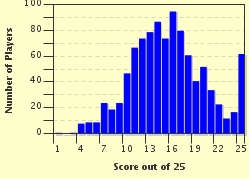Quiz Answer Key and Fun Facts
1. One of the symptoms of major depression, this term means a loss of enjoyment of the usual pleasures of life.
2. This infection was previously known as abattoir's disease because it was often acquired by people who worked in slaughterhouses. Now it is more frequently acquired by drinking unpasteurized milk.
3. The symptoms of measles are often remembered as an alliterative series beginning with a hard "c" sound. Which of the following is NOT one of the symptoms?
4. This disease is likely to be eradicated from the face of the earth in our lifetime. It is also known as "guinea worm" disease.
5. This viral infection is thought to be a zoonosis, meaning an infection spread from animals to people. It has a high mortality rate and occurs predominantly in Africa.
6. Sometimes an abscess can form in the pad of the fingertip, especially after a splinter injury or other minor trauma. What is the name given to this type of abscess?
7. Infection with this protozoan parasite was initially most common in people who drank fresh water during camping trips. Now, daycare attendance is recognized as one of the biggest risk factors. Symptoms include bloating and distention.
8. A patient with diabetes develops symptoms including shakiness, sweating, and confusion. What is the most likely cause?
9. Influenza is a major cause of illness and death around the world. In 1918, a terrible pandemic occurred, killing millions of people. What type of influenza caused this epidemic?
10. Many disorders have a different form that occurs in younger patients, which is thus given the adjective "juvenile" to distinguish the illness that occurs in children from the disease form in adults. Which of the following is NOT a proper term?
11. People who take warfarin (brand name = Coumadin) as an anticoagulant ("blood thinner") must limit foods rich in vitamin K. Which of the following foods is highest in vitamin K?
12. Signs and symptoms of this disease include a rash which is circular (up to several inches in diameter), joint aches/arthritis, facial nerve paralysis and meningitis.
13. Malnutrition comes in two basic types. What is the term for the type of malnutrition in which the person becomes completely wasted due to a complete lack of caloric intake?
14. What term is applied to infections which are acquired in a hospital rather than in the community?
15. True or False: Someone with a body-mass-index (BMI, weight in kg divided by height in meters squared) of 29 is obese.
16. Caused by a destruction of cells in the substantia nigra region of the brain, this movement disorder is characterized by a shuffling gait, tremor and rigidity.
17. True or False: Quinsy is a quaint term for an abscess behind the tonsil, an occasional complication of tonsillitis.
18. What is the name for the group of small, intracellular bacteria that cause diseases such as Rocky Mountain spotted fever and typhus?
19. Substitution of valine for glutamic acid in the amino acid structure of the hemoglobin molecule results in this disorder.
20. This disorder is characterized by multiple tics, barking or grunting vocalizations, and occasionally coprolalia (shouting obscene words). Affected children often have behavioral disorders as well.
21. Hives may form in response to exposure to allergens, changes in temperature (certain individuals) or during certain infections. What is the medical term for these itchy wheals?
22. Pernicious anemia, a disorder characterized by enlarged red blood cells present in decreased numbers, results from deficient absorption of which vitamin?
23. This mosquito-borne illness was originally described in Africa, but was found in Europe, the Middle East, Asia and Australia. In 1999, it spread to the Western hemisphere - it was originally detected in the New York/New Jersey area and is believed to have been spread by an infected bird or mosquito.
24. You knew this question would relate to Xrays! Which of the following types of radiographic procedures results in the largest dose of radiation to the patient?
25. This Swiss bacteriologist discovered the causative agent of plague. He is buried in Vietnam, where he opened the first medical school and a branch of the Pasteur Institute.
Source: Author
pusdoc
This quiz was reviewed by FunTrivia editor
crisw before going online.
Any errors found in FunTrivia content are routinely corrected through our feedback system.


